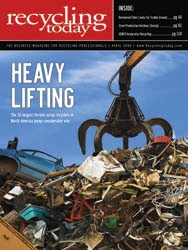I have always done what I call "sleeping donkey" deals. My career in the metal recycling business has involved a number of partnerships in companies that involved providing sweat equity, real estate or equipment to accomplish the goal in lieu of investing cash capital.
Such deals allow people to trade "what they have, but don’t need" for "what they need, but don’t have."
Sleeping donkey deals are based on the premise that everything a person or company owns is valuable to someone else and can be put to use to gain profit in the form of a negotiated percentage of ownership in a business.
EQUITABLE ARRANGEMENTS
One of the early deals that I worked on was with Kaiser Aluminum. We had a contract back in the 1980s to recycle all of its aluminum, copper and steel scrap.
Kaiser Aluminum was in the sleeping donkey structure in that the company "put" its scrap into the deal as opposed to selling it to my company.
With the material secured, I needed somebody who was highly motivated to run that scrap yard for me.
I didn’t have the money to pay a fulltime yard manager, but arranged to give half the yard’s profits to a colleague in exchange for the work. I provided the general direction, but on a daily basis he was the one that ran the scrap yard and implemented our plan for handling all of the material.
Again, later in my career, I was involved in a project with the U.S. government that was a huge sleeping donkey deal. The government was scrapping out its aircraft, helicopters and ships, and this particular contract focused on aircraft at Davis-Monthan Air Force Base in Arizona.
I was able to convince the government through the DRMS (Defense Reutilization and Marketing Service), the DLA (Defense Logistics Agency) and the office of the Pentagon to "put into the deal" all of its aircraft, so I wasn’t paying the agencies for them.
I had two other partners in the deal who were not putting in assets but who were putting in sweat equity. One was a retired officer of the U.S. Army who had done a lot of government contract work, and the other was an expert at the legal aspects of federal acquisition regulation who helped us with the language in the contract.
We were finally awarded in 1995 what we were told was the largest contract that the U.S. government had ever given to scrap 6,000 aircraft and all of the associated parts. This entire arrangement was done with no cash capital to speak of. It was the government putting in what it had, which were the assets, and it was my partners putting their expertise into the deal.
A CAPITAL IDEA? Rick Fine, an Alabamian with a background in the metals industry, says now could be the right time for scrap recyclers to consider non-traditional funding and capital sources, and he has a sleeping donkey that can help. Fine created www.SleepingDonkey.com to act as a bulletin board and virtual marketplace for companies and individuals who have an underutilized asset or may have insufficient capital to make a major investment (the sleeping donkeys for whom the site is named). Fine says he conceived of the Web site almost 10 years ago but has waited to launch the concept. Now, he says, a greater number of people (recyclers in particular) are more comfortable doing business on the Web than they were then. "They can understand it and appreciate it better," Fine says. Web familiarity is one reason Fine hopes Sleeping Donkey will garner more attention this year, but the state of financial markets is another. The tight credit markets "demand creative solutions," Fine says. "SleepingDonkey.com is being launched into an economy where credit is extremely difficult to obtain to start up a new business as well as expand on a current business." More information can be found at www.SleepingDonkey.com. – Brian Taylor
A little later on in my career I had another sleeping donkey partnership with a company called TFI. An individual at TFI operated cleaning equipment for washing scrap. He would wash the material and centrifuge it for customers, so they could have a better idea of what alloys were present and improve their recovery. He had some pretty substantial equipment that was probably worth $2 million or more and he "put" that into the deal.
I had another partner who had many copper and alloy customers. He brought his relationships with copper and brass businesses and alloy companies to the partnership to procure feedstock for washing and cleaning truckload quantities of turnings. I "put" or added in my idea to have these companies work together. All three of us had something to offer. Again, with very little or no cash, we came together to do a deal.
TRIED AND TRUE
This structure is familiar to most of us in the scrap industry. Many people in the industry can probably think of examples they’ve taken part in or heard about.
Recyclers can make arrangements using land, buildings, equipment, sweat equity, idled capacity or contracts or make deals where they aggregate those pieces into a whole.
The author is the founder of property- and service-for-equity trading site www.SleepingDonkey.com.

Explore the April 2009 Issue
Check out more from this issue and find your next story to read.
Latest from Recycling Today
- Aqua Metals secures $1.5M loan, reports operational strides
- AF&PA urges veto of NY bill
- Aluminum Association includes recycling among 2025 policy priorities
- AISI applauds waterways spending bill
- Lux Research questions hydrogen’s transportation role
- Sonoco selling thermoformed, flexible packaging business to Toppan for $1.8B
- ReMA offers Superfund informational reports
- Hyster-Yale commits to US production





